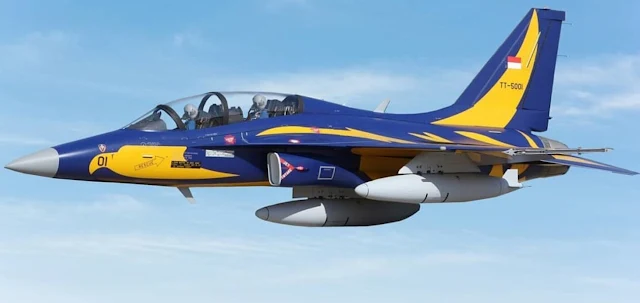 |
| Indonesian Air Force T-50i Golden Eagle Trainer Aircraft |
Jakarta - The Indonesian military aviation world is grieving again, because the T-50i Golden Eagle trainer jet belonging to the Indonesian Air Force crashed and crashed. The Indonesian Air Force's T-50i Golden Eagle trainer jet crashed in Blora Regency, East Java.
At the time of the accident, the T-50i Goden Eagle jet trainer was piloted by First Lieutenant Pnb Allan Safitra. Based on the information received, the T-50i Golden Eagle accident occurred during a night tactical intercept exercise on July 18, 2022 last night.
Quoted from tni-au.mil.id, the T-50 Golden Eagle is a Korean-US-made supersonic trainer aircraft. This trainer aircraft was developed by KAI in collaboration with Lockheed Martin.
Read Also: T-50 Golden Eagle vs Yakovlev Yak-130, Which Is Superior to the South Korean or Russian Jet Trainer?
The development of the T-50 Golden Eagle jet trainer with a 13% share was financed by Lockheed Martin. Then 17% by Korea Aerospace Industries, and 70% by the South Korean government.
Quoted from aerocorner.com, it is explained that the KAI T-50 Golden Eagle is a series of supersonic advanced training aircraft which is also a light fighter aircraft. The T-50 Golden Eagle is South Korea's first original supersonic aircraft and one of the few supersonic trainers in the world.
In February 2000, the aircraft was officially named the T-50 Golden Eagle. The first final assembly started from January 15 to September 14, 2011.
In August 2002, the T-50 made its maiden flight. The initial operational assessment took place from 28 July to 14 August 2003. KAI is currently working with Lockheed Martin on the T-50 international co-marketing program.
In December 2003, the South Korean Air Force entered into a production contract for twenty-five aircraft, which are expected to be delivered from 2005 to 2009. The T-50 Golden Eagle is equipped with digital fly-by-wire control and direct throttle-and-stick.
The cockpit of the T-50 Golden Eagle includes two multifunctional displays by Honeywell, an instrumentation display and a heads-up display from BAE Systems. Lockheed Martin developed a full authority digital flight control system and avionics.
The flight equipment incorporates a navigation/attack system, Honeywell H-764G embedded global inertial positioning/navigation system, and HG9550 radar altimeter, as well as a Collins Aerospace VIR-130A/instrument landing system, and the ARN-153V advanced digital TACAN receiver. The cockpit is equipped with Onboard Oxygen Generating System (OBOGS) and ejection seats from Martin-Baker.
The T-50 Golden Eagle has an exterior length of 13.14 meters, a height of 4.94 meters and a fuselage diameter of 1 meter. It is equipped with a retractable tricycle undercarriage from the Messier Dowty and the wheelbase is 5.2 meters.
The General Electric F404-102 turbofan engine powers the T-50 Golden Eagle. This engine has a maximum power of 17,700 lbf. The T-50 has a maximum cruising speed of 992 knots and a travel range of 999 nautical miles. The service ceiling is 48,000 feet and the ascent rate is 39,000 feet per minute.
The T-50 Golden Eagle is equipped with a Messier Dowty tricycle retractable landing gear. Each unit is single wheeled and equipped with oleo pneumatic shock absorbers, the main wheels are pulled into the engine air inlet rods and the nose wheel is pulled forward.
In the airforce-technology.com upload, it is explained that the T-50 Golden Eagle has seven internal fuel tanks. Its locations are five on the fuselage and two on the wings, which can carry 2,655 liters of fuel with the option of three additional 570 liters of external fuel tanks.
